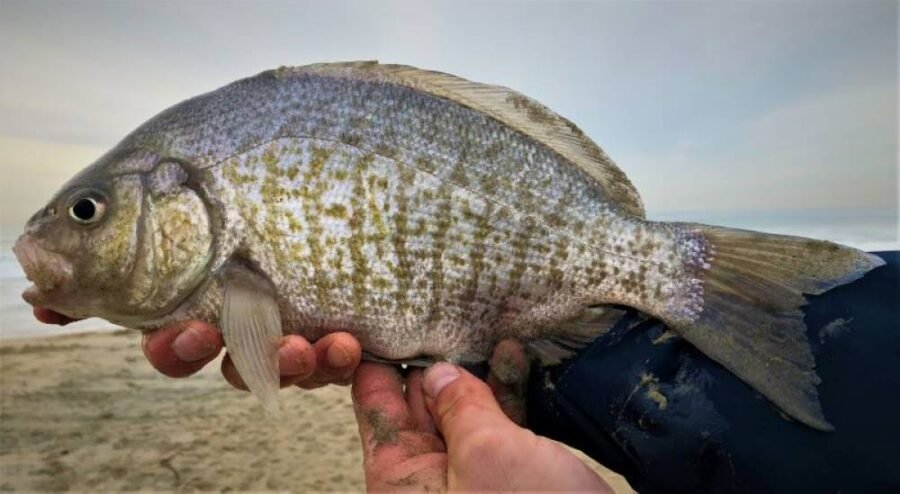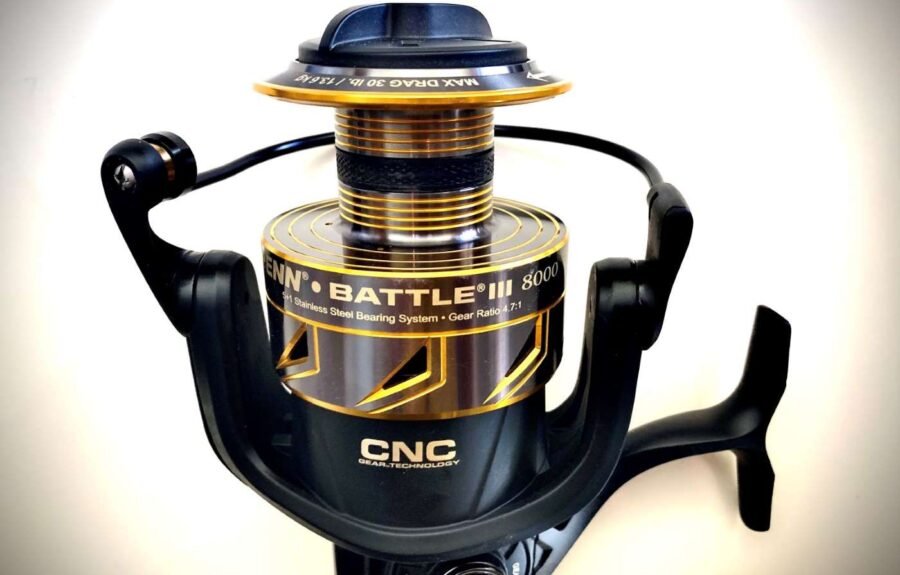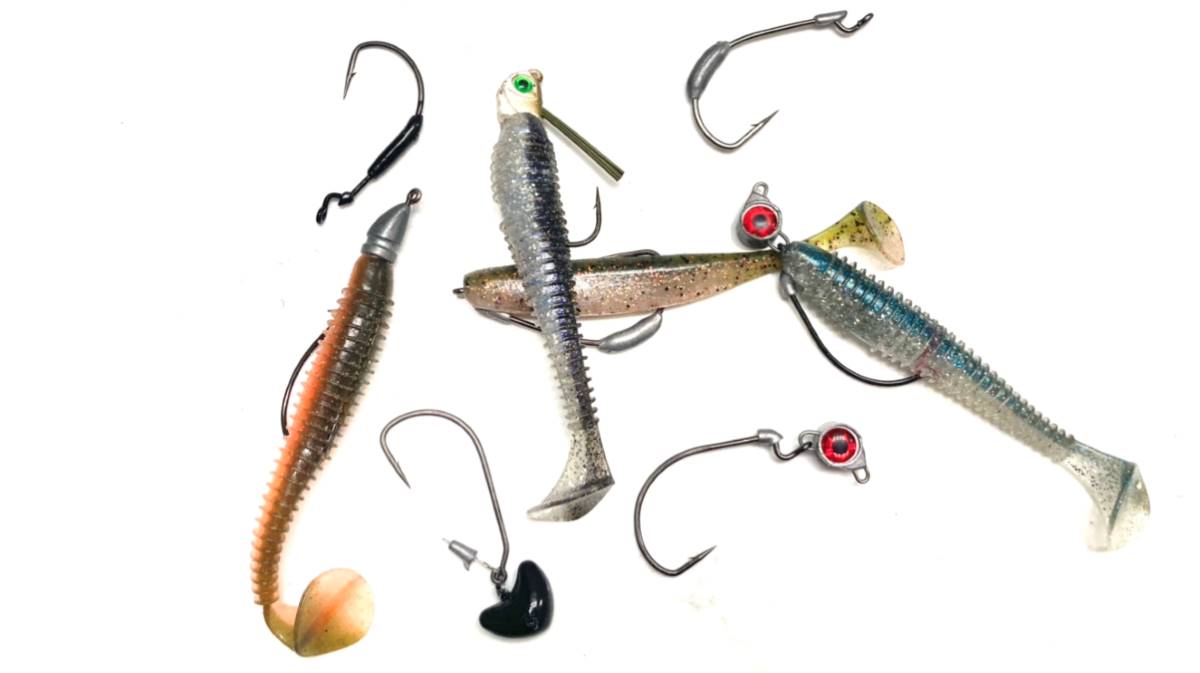9 Ways To Accidentally Kill A Fish: Fish Handling 101
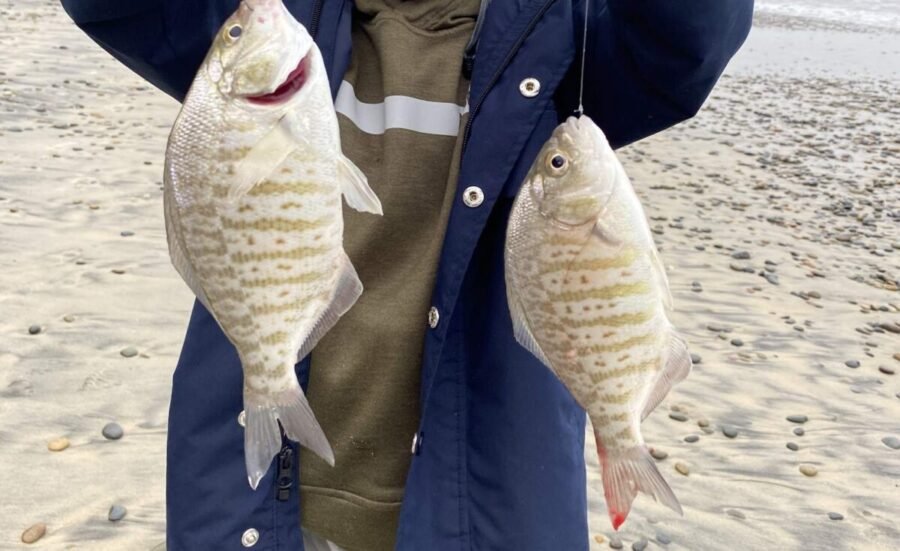
Whether you’re fishing to keep and eat or you’re strictly catch and release, learning how to properly handle fish is extremely important. In this article, we’ll be talking about how to handle fish when you’re planning to release your catch and point out 9 common mistakes in fish handling.
It’s not uncommon for online battles and debates to break out after anglers post images featuring improper fish handling. It’s a topic of tension for many and it’s understandable as to why. Learning how to properly handle a fish will provide the best odds that your catch goes on to live and reproduce. Afterall, that is every angler’s intention when they release a fish they’ve caught.
What Can Improper Fish Handling Do To Fish?
We’ll be going into detail on all of this, but in short, improper fish handling can cause injury or stress to the fish. This can lead to decreased survival rates and a decrease in reproduction. Some common direct results of improper fish handling include damage to the fish’s gills, fins, scales, internal organs and the removal of the protective slime coat – making the fish more susceptible to disease. This can all lead to decreased fish populations and can negatively impact the ecosystem.
Proper fish handling is also important for food safety and consumption. Fish that are handled improperly can be contaminated by bacteria or other contaminants, which can make them unsafe to eat. Additionally, improper handling can also affect the quality of the fish meat, making it less desirable for consumption. I’ll talk about this later in another article.
What’s the Best Way to Unhook a Fish?
The best way to unhook a fish depends on the type of fishing and the type of hook used. Here are a few general guidelines for unhooking a fish safely:
- Hold the fish in a manner that supports the fish’s weight, secures the fish and is gentle on the fish.
- Use a pair of quality fishing pliers.
- If the hook is deep inside the fish’s mouth, it’s best to cut the line as close to the hook as possible and leave the hook in the fish. The hook will eventually rust/fall out.
- When unhooking a fish keep your fingers away from the fish’s gills, eyes, and sharp fins.
- If the fish is to be released, make sure to do so gently, with minimal handling and avoid dropping it (for the most part) back into the water. The fish should be held vertically in the water, facing the current and move it gently forward, to allow the water to flow over its gills and revive it before release.
- Additional Clarification: I will often drop fish from very low heights back into the water and I do so in a way that supplies a rush of oxygen to the gills of the fish by angling the fish to “torpedo forward” when it breaks the water surface. I think this is beneficial to a fish’s quick recovery. Also, in the surf, “current” is an ambiguous word here. Basically, always point the fish so that water is flowing into the fish’s mouth and out the gills and avoid “back and forth” revival. More on this as we start talking about the common mistakes in fish handling below.
How to Handle a Fish: What’s the Best Way?
The best way to hold a fish is by using a wet and soft hand or a fish landing net. Fish landing nets are much more common with fly fishing in rivers and streams, but can be used for most types of fishing.

When using your hands, it’s important to support the fish’s weight (especially where internal organs may need support) by holding it gently under its pectoral area. Use one hand to gently support the front side of the fish (usually just in front of the pectoral area), and use the other to do the same by the tail base. This allows you to control the fish without causing damage to its fins, scales, and gills. In simpler terms, evenly distribute the weight of the fish by supporting as much of its weight as possible while minimizing stress and abrasion. There are numerous ways to do this, but the photo above shows a very good way of holding a fish.
9 Common Mistakes in Fish Handling
Before we touch on all these common mistakes anglers make. I would like to personally recognize that I’ve been guilty of a few of these mistakes. In fact, a couple images in this article are of my very own mistakes. It took me years to learn how to hold a fish and it still changes per species. No angler is perfect and each of us started out a beginner. The most important factor here is a willingness to learn and to do better in the future.
#1 Tail Splits

Since we didn’t talk about the proper way to use a landing net, let’s start with the main mistake people make with fishing nets.
When using a fish landing net, it is important to use a net made of a soft material, such as rubber or nylon, to avoid harming the fish. If you use a net that has holes that are too big, or mesh made of thin/sharp material (i.e. rope or similar material), you run the risk of “tail splits”. This is when the tail of the fish literally splits which results in a less effective and efficient swimming capability for the fish.
Take a look at the image above and you’ll see the tail of this corbina has split. It’s worth noting that this was my catch and I was not the one who caused the tail split as I don’t use landing nets in the surf. That said, it fought very well and seemed to be living its life fine in its current state. Nonetheless, it isn’t ideal for the fish.
But again, if you decide to use a landing net, the fish should be gently scooped into the net and then carefully lifted out of the water. Once the fish is out of the water, it should be supported with the same or similar technique as mentioned above. This allows the fish to be controlled while minimizing stress and damage.
#2 Touching Fish Gills: Why You Shouldn’t Touch a Fish’s Gills

Touching a fish’s gills can damage or disrupt the delicate filaments that form the gills, making it difficult for the fish to breathe and can potentially cause death. The image above is one of the worst ways you can possibly handle a fish when planning to release it. The odds of this fish surviving a release would be very slim due to the sand likely removing much of its slime along with its gills being damaged by the finger hang. Touching a fish’s gills can also introduce harmful bacteria or other contaminants from human skin (or elsewhere) to the fish, potentially causing infection or illness.
#3 Fish Slime and Gloves

Wearing gloves when handling fish is not recommended as it can cause harm to the fish in several ways. Firstly, gloves can remove the fish’s protective slime coat, leaving them vulnerable to disease and parasites. The slime coat also helps the fish to swim efficiently and protects them from environmental stressors. Removing this slime coat can make it difficult for the fish to survive. For more on fish slime, read the linked article.
As for fishing gloves, they can also introduce harmful bacteria or other contaminants to the fish. The fish’s gills are particularly sensitive and can easily be damaged by bacteria or other contaminants, leading to infection or illness. Additionally, gloves can can make it easier to cause physical damage to the fish by squeezing or scraping their fins and scales. This can lead to injuries and bleeding, which can be fatal for the fish. Ultimately, it’s best to handle fish with clean, wet hands to minimize the risk of harm to the fish.
#4 The Death Squeeze… Please, Don’t Squeeze the Fishy

If you didn’t already know, squeezing a fish is not one of the best ways to handle a fish. Squeezing a fish when handling it can cause significant harm to the fish and should be avoided at all times. Firstly, squeezing a fish can damage its internal organs and cause internal bleeding. Fish do not have a skeletal structure to protect their internal organs and squeezing can easily cause serious injury.
Secondly, squeezing a fish can also cause physical damage to its scales and fins. The scales and fins of a fish are delicate and easily damaged, and squeezing can cause scraping, tearing or bleeding. This can cause avoidable pain and discomfort for the fish, and can also increase the fish’s susceptibility to disease and infection. And as if we haven’t talked about fish slime enough, squeezing a fish can also remove its protective slime coat, making it more vulnerable to infections etc. Overall, it’s important to handle fish gently and avoid squeezing or applying any unnecessary pressure on them.
#5 Over-Handling… For a Photo
We’ve all been in a situation where you catch something you really want a photo of, you want to release it, but you’re camera or phone happens to be either tough to access, or borderline too far away. The best thing to do for the fish is pretty straight forward, but we all know that’s not always how it goes. There are a few ways to avoid finding yourself in this situation and they all involve preparedness and a game plan.
My first piece of advice would be to have your camera/phone easily accessible enough to snap a quick photo and get her back into the water.
My second piece of advice would be to have a game plan going in as to whether or not you’re able/prepared to keep a fish. If you are, have the wherewithal to make a decision on the spot to keep the fish. In that case, you don’t need to worry about the time it’s going to take to get a good photo.
Like I said, there are handful of ways to avoid finding yourself in the situation depicted earlier, so just think ahead, have a plan, and have everything you need for surf fishing. At the end of the day, if you’re releasing your catch, it’s important to handle the fish as little as possible and to release it back into the water as soon as possible.
#6 Avoid Dropping the Fish

In the image above, you can tell the fish has been dropped because there’s sand on it’s scales. I can also tell because I’m the one who dropped it. Like I said, I’m guilty too. I’m sure it doesn’t come as a shock to any of us that when you drop a fish, it isn’t good for the fish. From mechanical and organ damage to slime and mucus membrane removal, dropping a fish can have adverse effects on a fish’s health for various reasons.
#7 Don’t Hang a Fish: How to Hold a Fish
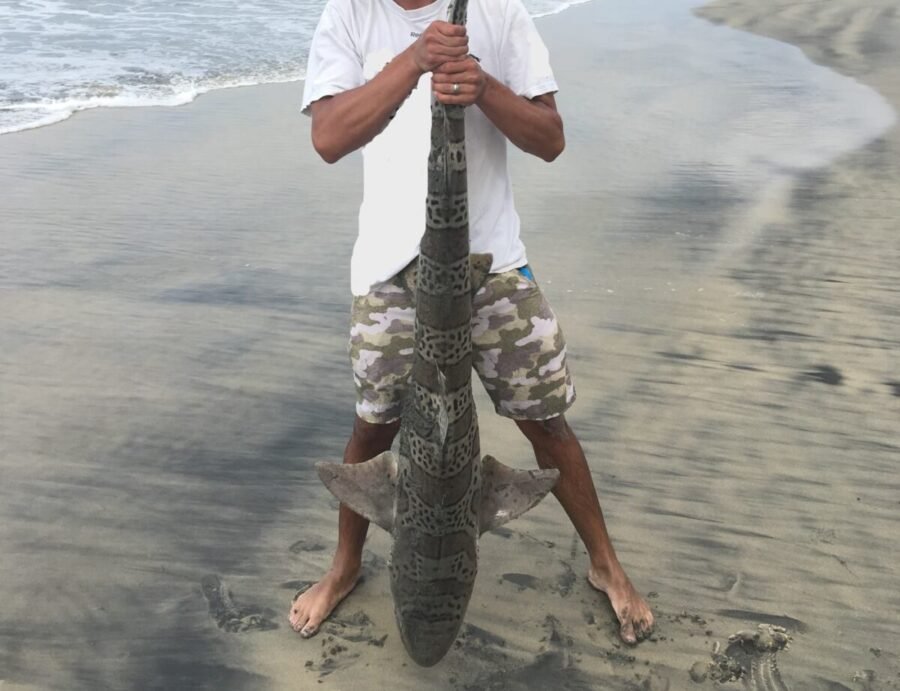
In the image above, you’ll see a leopard shark being held from the tail. I’ve done this a couple times along with my buddy in our earlier years of fishing and at least in our opinion, it likely wasn’t good for the fish. In my opinion, the following should go for all fish. If it’s too big to support the weight evenly, don’t pick it up. See more about leopard shark fishing in this video.
Hanging a fish by its mouth, gills or tail (or even by the hook as shown in the first image of this article) when handling it is not recommended as it can cause significant harm to the fish. All the points of tension are at risk of injury and it can absolutely damage the fish’s internal organs, and even cause the fish to suffocate.
If you’ve ever heard about how whales and other large sea creatures can be killed just by the effects of gravity on land, it doesn’t take much to connect the dots. Hanging a fish so that all of its blood and organs rush to one side of the fish, simply put, cannot be good for the fish.
#8 Avoid Back and Forth Revival for Proper Fish Handling
When reviving a fish, it is generally recommended to move it gently against the water flow (forward) rather than moving it back and forth. This is because moving the fish against the water flow allows water to flow through its mouth and out its gills. If you understand the basics of how fish receive oxygen, it makes sense that this technique helps to re-oxygenate a fish’s blood.
Many anglers resort to “back and forth” revival. This is a less effective method because you’re deliberately stopping the fish from receiving oxygen at times. Fish take water in through their mouth and expel it through their gills. It doesn’t work the opposite way so do your best to always face the fish against the waterflow.
In the surf, I’ll actually rotate myself in a circle (essentially drawing a circle in the water as I turn 360 degrees) until the fish seems strong enough to swim off. Be smart about it and if a wave is coming in, face the fish toward the wave, if the waves are beginning to get sucked out as they recede, keep the fish moving forward in your circle pattern and face it toward the shore to keep water flowing over its gills.
#9 Lip Grip Turned Jawbreaker

Before I talk about this technique of how to handle a fish, you’re all likely wondering where the fish’s eye went. It’s possible that it was due to a previous lure, but it’s also possible a predator or even parasite is to blame. That said, in terms of fish handling, treble hooks on lures like jerkbaits can present tricky situations to maneuver that may lead to scenes like the one shown above. Some anglers make a point to remove all treble hooks and switch to inline. Others just remove some hooks if there are more than one on a lure.
The lip grip will likely meet a lot of tension with bass fishermen. At the end of the day, some people are good enough (and fast enough) at what they do to the point that they find a way that’s “not bad” for the fish. But, it can’t really be argued that supporting the fish from underneath is better.
the bigger concern, however, is if you try to manipulate the rest of the fish’s body weight simply by holding its jaw. If you do this, you’re likely doing some damage to the fish.
Subscribe to our newsletter!
